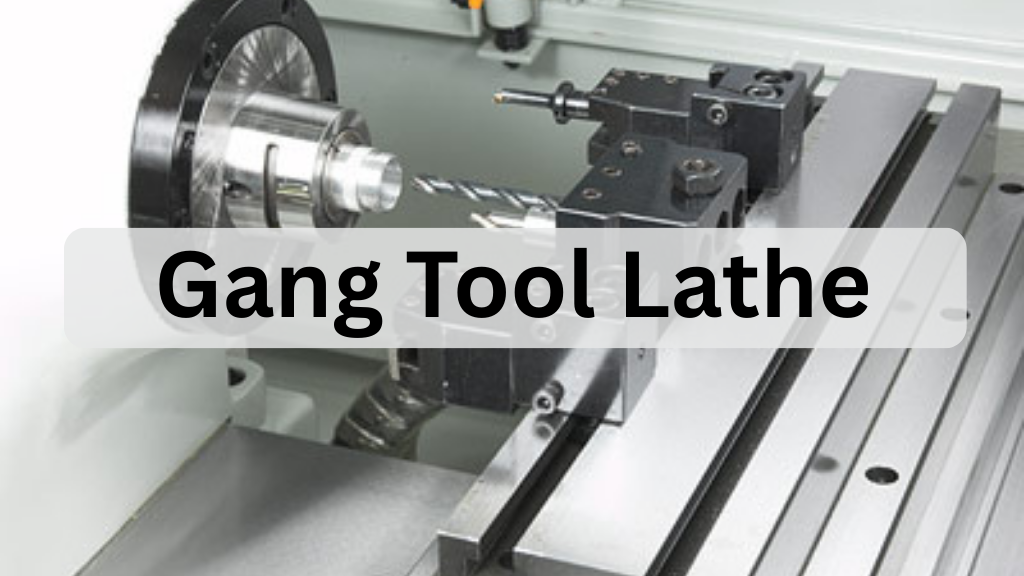In modern manufacturing, precision and efficiency are critical to meeting production goals. One machine that exemplifies both is the gang tool lathe. This specialized type of lathe is designed for high-speed, high-accuracy machining of small to medium-sized parts. For manufacturers, machinists, and production managers, understanding the unique advantages of a gang tool lathe is essential for optimizing workflow and reducing downtime.
This guide will explore everything about gang tool lathes, including what a gang tool lathe is, how it works, the differences between turret and gang tooling, applications across industries, and best practices for maintenance and productivity.
What Is a Gang Tool Lathe
A gang tool lathe is a CNC lathe designed to hold multiple cutting tools on a single slide. Unlike traditional lathes that require frequent tool changes, a gang tool lathe allows several operations to be performed sequentially without stopping the machine. This results in faster production cycles and higher accuracy.
Gang tool lathes are ideal for producing small parts in high volumes, especially when precision and consistency are required. They are commonly used in industries such as automotive, aerospace, electronics, and medical device manufacturing.
Key Features of Gang Tool Lathes
- Multiple tools mounted side by side on a single slide
- High precision due to minimal tool deflection
- Compact design suitable for small to medium workpieces
- Ability to perform multiple operations in one setup
- Versatile for turning, threading, drilling, and grooving
The combination of these features makes gang tool lathes highly efficient for repetitive and high-precision tasks.
How Gang Tool Lathes Work
Gang tool lathes operate by moving the workpiece against fixed tools mounted on a gang slide. Each tool performs a specific operation, and the lathe automatically moves the workpiece to the next tool. This reduces the need for manual intervention and allows for faster machining cycles.
Process Overview
- Secure the workpiece in the lathe chuck.
- Select the pre-mounted tools required for the sequence of operations.
- Machine the part sequentially using the fixed tools.
- Complete finishing operations without repositioning the workpiece.
This workflow reduces downtime, increases repeatability, and ensures uniformity across multiple parts.
What Is the Difference Between Turret and Gang Tooling
Both turret and gang tooling aim to improve productivity and reduce setup time, but they operate differently. Understanding these differences can help manufacturers choose the right solution for their specific production needs.
Turret Tooling
This turret tooling features tools mounted on a rotating turret that indexes each tool into position when needed. Turret lathes are typically used for larger, more complex workpieces.
Advantages of turret tooling include:
- High flexibility for tool arrangement
- Suitable for larger and more complex parts
- Ability to handle heavy-duty machining
Limitations include:
- Slower operation due to turret rotation
- Bulkier machine design requiring more space
Gang Tooling
Gang tooling, in contrast, has fixed tools mounted on a linear slide. The workpiece moves to each tool, allowing for rapid sequential machining.
Advantages of gang tooling include:
- Faster operation for small to medium parts
- High accuracy due to minimal tool deflection
- Compact design suitable for smaller workshops
Limitations include:
- Limited tool capacity per slide
- Less flexibility for very complex parts
Quick Comparison Table
| Feature | Turret Tooling | Gang Tooling |
|---|---|---|
| Tool Movement | Rotates on turret | Fixed on slide |
| Speed | Moderate | Fast |
| Ideal For | Larger, complex parts | Small to medium, repetitive |
| Setup Flexibility | High | Moderate |
| Accuracy | Good | Excellent |
Applications of Gang Tool Lathes
Gang tool lathes are versatile machines used across multiple industries due to their speed, accuracy, and efficiency. From mass production to custom machining, they provide reliability and precision in handling both small and large-scale projects.
-
Automotive Industry
Gang tool lathes play a major role in the automotive sector for producing bushings, shafts, and fasteners. Their ability to handle repetitive tasks with precision ensures consistent output. Reduced setup time allows manufacturers to meet mass production demands efficiently. This makes them essential in high-volume automotive operations.
-
Electronics Industry
In electronics, these machines are used to create small, detailed parts such as connectors, pins, and housings. The compact nature of electronic components requires high accuracy, which gang tool lathes deliver. With multiple tools mounted, production is faster and smoother. As a result, they excel in manufacturing intricate electronic components.
-
Medical Industry
Medical device production often demands extreme precision and smooth finishes. Gang tool lathes are ideal for manufacturing implants, surgical tools, and other healthcare equipment. Their accuracy supports strict medical standards and safety requirements. Quick adjustments further enhance their role in producing reliable medical components.
-
Aerospace Industry
The aerospace industry requires components with tight tolerances and strong materials. Gang tool lathes provide efficient machining while minimizing tool changeovers. This ensures streamlined workflows and consistent results. Their precision and durability make them highly valuable in aerospace manufacturing.
-
Custom Manufacturing and Prototyping
Beyond large-scale industries, these lathes are used in small workshops and custom projects. Their versatility allows the creation of unique parts and prototypes. Reduced setup time supports faster delivery for one-off or limited production runs. This makes them a cost-effective solution for specialized machining needs.
Advantages of Using a Gang Tool Lathe
Gang tool lathes offer several benefits that make them popular in modern machining. They combine speed, accuracy, and flexibility in one compact design. For manufacturers handling repetitive production, these machines are highly valuable. Their efficiency makes them a cost-effective choice for workshops.
1. Reduced Setup Time
Setup time is significantly lower compared to traditional lathes. Multiple tools can be mounted at once, reducing downtime between processes. This arrangement supports faster changeovers during complex runs. The result is higher productivity with minimal delay.
2. Higher Productivity
Faster machining cycles ensure maximum output in less time. Repetitive operations become streamlined with minimal operator involvement. Consistent speeds also prevent variations in production quality. This makes them ideal for industries requiring large volumes.
3. Improved Dimensional Accuracy
Gang tool lathes provide high accuracy with minimal tool travel. Reduced movement lowers the chance of alignment errors in parts. This ensures consistent results across every production cycle. For precision components, they deliver excellent reliability.
4. Cost Efficiency
Although the initial cost may be high, long-term savings are clear. Lower setup times and higher accuracy reduce wasted material. This efficiency translates into better cost per unit produced. Over time, the investment pays for itself.
5. Compact Design
The compact build makes these machines space-friendly. Workshops with limited floor space benefit from their smaller footprint. Despite their size, they still offer strong machining capabilities. This combination of power and efficiency is highly valuable.
Choosing the Right Gang Tool Lathe
When selecting a gang tool lathe, it is important to evaluate the size and complexity of the parts you plan to produce. Smaller, simpler parts may require fewer tool stations, while larger or more intricate parts demand more robust setups. The right choice ensures smoother operations and higher-quality results. Careful assessment of part requirements is the first step in narrowing down machine options.
-
Production Volume and Throughput
Production volume is another key factor when choosing a gang tool lathe. If your operations demand continuous, high-speed production, you need a machine designed for durability and efficiency. Lathes built for high throughput reduce downtime and increase profitability. For smaller batches, a less complex machine may be sufficient. Matching production capacity with machine capability prevents costly inefficiencies.
-
Tooling and Station Requirements
The tooling setup plays a major role in achieving precision and efficiency. Gang tool lathes offer multiple tool stations, but the number varies by model. Understanding your specific tooling needs ensures you select a lathe with adequate flexibility. A machine with too few tool positions limits capabilities, while excessive stations may increase costs. Balancing requirements against capacity ensures smarter investment.
-
Budget and Cost-Effectiveness
Budget constraints often guide the final decision when selecting a lathe. While premium machines deliver greater reliability and longevity, they also involve higher upfront costs. However, focusing only on initial price may lead to higher maintenance and downtime expenses later. Evaluating total cost of ownership helps determine real value. A balanced approach ensures long-term savings and efficiency.
-
Material and Hardness Considerations
The type of material being machined also affects machine choice. Softer materials like aluminum may not require the same rigidity as harder metals such as stainless steel or titanium. Selecting a machine built to handle your primary materials ensures consistent performance. Harder materials also require more powerful spindles and durable tooling. Matching lathe capabilities with material needs guarantees optimal machining results.
Maintenance and Best Practices
Maintaining a gang tool lathe is essential for longevity, precision, and consistent output. Regular care helps prevent breakdowns and supports smooth operation. Neglecting upkeep can lead to costly downtime. A well-maintained lathe ensures maximum productivity.
-
Key Best Practices
Operators should regularly check and align tools to prevent uneven wear. Lubrication systems must be maintained for smooth slide motion. Tool holders should be inspected for cracks or deformation. Spindle and motor performance should also be closely monitored.
-
Maintenance Logs
Keeping a detailed maintenance log is highly recommended for gang tool lathes. It allows operators to track servicing schedules and identify recurring issues quickly. Logs ensure timely lubrication, adjustments, and inspections are carried out. This systematic approach greatly improves overall reliability and performance.
-
Benefits of Proper Maintenance
Consistent upkeep reduces unexpected downtime and prolongs tool life. It also ensures high-quality output with precise finishes. By following best practices, manufacturers improve efficiency and lower costs. In the long run, proper maintenance maximizes return on investment.
Real-World Case Study
A precision components manufacturer faced the challenge of producing high volumes of small metal shafts. By implementing a gang tool lathe with multiple pre-mounted tools, the company achieved the following results:
- Machining time reduced by 40 percent
- Improved dimensional accuracy by 25 percent
- Return on investment achieved within 12 months
This case highlights how gang tool lathes optimize workflow, improve quality, and deliver measurable benefits for manufacturers.
Tips for Maximizing Efficiency
To get the most out of a gang tool lathe:
- Plan tool sequences carefully to minimize movement
- Use sharp, high-quality cutting tools for consistent results
- Regularly inspect slides and mounts for wear or misalignment
- Monitor production cycles and adjust feed rates for optimal performance
- Train operators on proper setup and machining techniques
Implementing these tips ensures that gang tool lathes operate at peak efficiency.
Common Misconceptions About Gang Tool Lathes
There are several misconceptions that may prevent manufacturers from fully utilizing gang tool lathes:
- They are only for large-scale production. In reality, they are highly effective for small to medium parts.
- Gang tool lathes cannot handle complex machining. While they are ideal for repetitive parts, they can be adapted for moderate complexity.
- Turret lathes are always better. The choice depends on part size, production volume, and desired speed.
Understanding the true capabilities of gang tool lathes helps businesses make informed decisions.
Conclusion
Gang tool lathes are essential machines for modern manufacturing, offering speed, precision, and efficiency for small to medium-sized parts. Understanding what a gang tool lathe is, how it works, and the differences between turret and gang tooling enables manufacturers to make informed decisions that improve workflow and reduce costs.
By implementing proper maintenance, planning tool sequences, and training operators, companies can maximize productivity and quality. Gang tool lathes remain a valuable investment for manufacturers seeking high-efficiency machining and consistent results.
FAQs
What materials can be machined on a gang tool lathe
Gang tool lathes can machine aluminum, brass, steel, plastics, and some exotic alloys. Tool selection depends on material hardness and finish requirements.
Can a gang tool lathe replace a turret lathe
It depends on production requirements. Gang tool lathes are faster for small to medium parts, while turret lathes provide more flexibility for larger and more complex workpieces.
How many tools can a gang tool lathe hold
Typically, a gang tool lathe holds between four and twelve tools, depending on the slide length and tool size. Some models can accommodate more tools for specialized operations.
Are gang tool lathes suitable for prototyping
Yes, they are suitable for prototyping, especially for small parts, due to their speed, precision, and efficiency.
Which industries benefit most from gang tool lathes
Industries such as automotive, electronics, medical devices, aerospace, and custom manufacturing benefit most from gang tool lathes.




